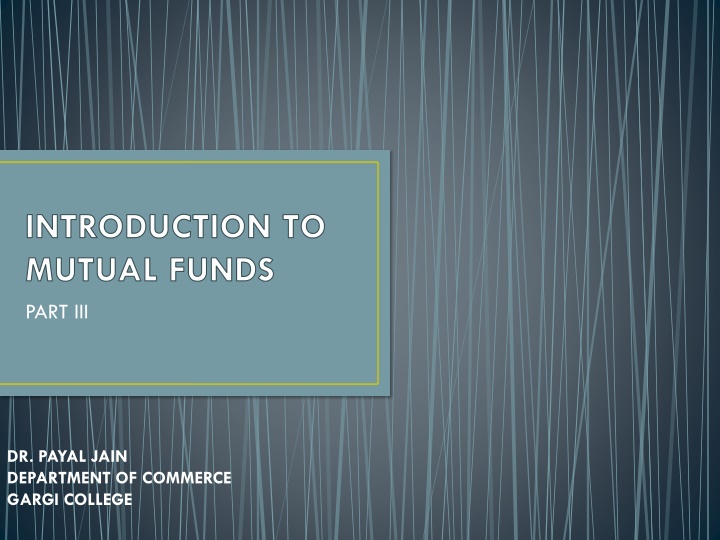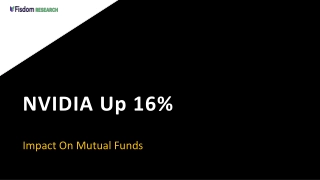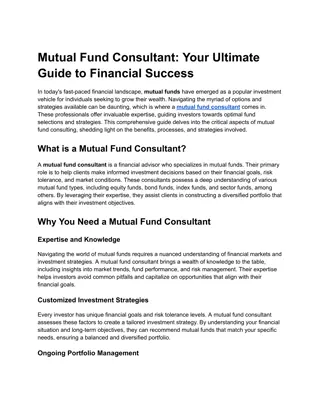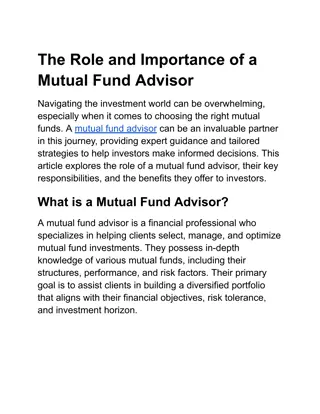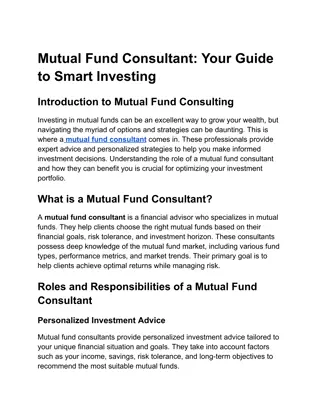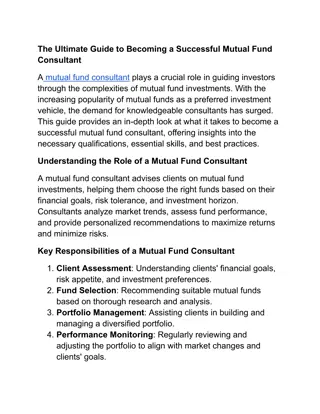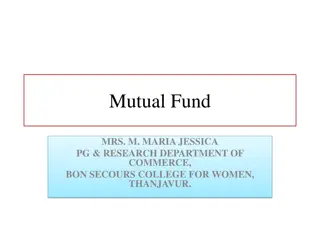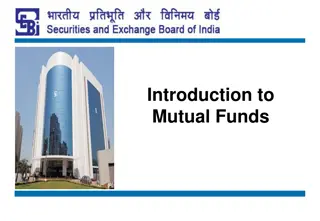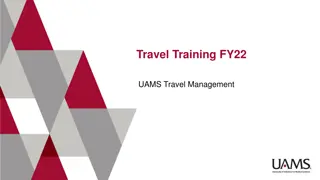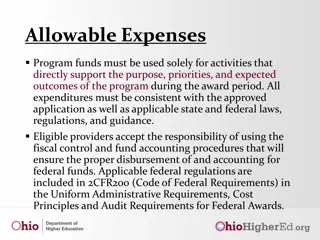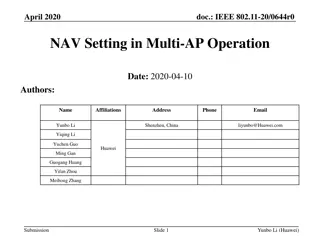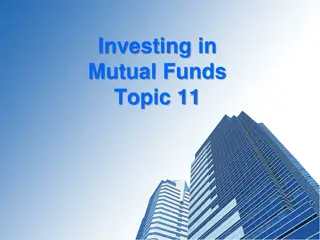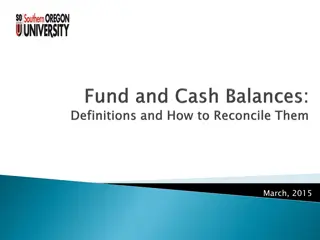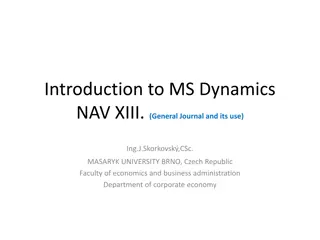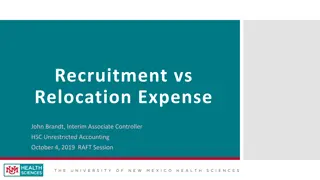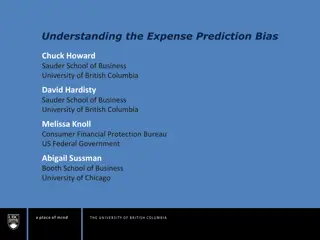Mutual Funds: NAV, Expenses, and More
Dive into mutual funds to grasp concepts like Net Asset Value (NAV), fund expenses, and the factors influencing a mutual fund's value. Learn about ongoing expenses, loads, and the impact of costs on fund performance.
Download Presentation

Please find below an Image/Link to download the presentation.
The content on the website is provided AS IS for your information and personal use only. It may not be sold, licensed, or shared on other websites without obtaining consent from the author.If you encounter any issues during the download, it is possible that the publisher has removed the file from their server.
You are allowed to download the files provided on this website for personal or commercial use, subject to the condition that they are used lawfully. All files are the property of their respective owners.
The content on the website is provided AS IS for your information and personal use only. It may not be sold, licensed, or shared on other websites without obtaining consent from the author.
E N D
Presentation Transcript
INTRODUCTION TO MUTUAL FUNDS PART III DR. PAYAL JAIN DEPARTMENT OF COMMERCE GARGI COLLEGE
NET ASSET VALUE Price of is stock is determined by demand and supply forces. On the other hand, a mutual fund s value is determined by how much is invested in the fund as well as the costs to run it, and its number of outstanding shares. Value of assets = value of all securities in the portfolio Value of liabilities = value of all liabilities and fund expenses The NAV of a fund is the fund s per share market value It is the price at which an investor would buy from or sell to the fund company. NAV per unit tells us how much one share of the fund is worth.
NET ASSET VALUE. contd.. NAV per unit = Net Asset Value of the Fund / Number of Units Outstanding Net Assets = [ Market Value of Investments + Receivables + Accrued Incomes + Other Assets ] - [ Accrued Expenses + Payables + Other Liabilities ]
EXAMPLE Value of securities = Rs. 75 lakh Cash = Rs. 15 lakh Accrued income = Rs. 24 lakh Short-term liabilities = Rs. 1 lakh Long-term liabilities = Rs. 12 lakh Number of outstanding shares = 20 lakhs NAV per unit = [Rs. 75 lakh + Rs. 15 lakh + Rs. 24 lakh ]- [Rs. 1 lakh + Rs. 12 lakh] / 20 lakhs NAV per unit = Rs. 101 lakh/20 lakh = Rs. 5.05 per unit
COSTS INCURRED BY MUTUAL FUNDS Every mutual fund house incurs expenses. According to rules, mutual funds deduct a small portion from investors investments to pay for these expense Equity funds are allowed to charge up to 2.25% of the assets that a scheme manages. Debt funds expenses are capped at 2%. The lower the expense ratio of a scheme, the higher the NAV. However, while expense ratio is important, it should be borne in mind that it is not the only criterion while selecting mutual fund scheme. A scheme with a consistently decent track record, but a higher expense ratio may be better than the one which lower expense ratio, but gives poor returns . - AMFI
COSTS OF NVESTING IN A MUTUAL FUND ANNUAL CHARGES DUE TO ON-GOING RECURRING EXPENSES (called Expense Ratio) ONE-TIME CHARGES or LOADS
ON-GOING/RECURRING EXPENSES Asset management companies (AMCs) manage the assets of the mutual funds and take the investment decisions. AMCs charge investors for professional fund management i.e. the investment management and advisory fees, which are charged annually. Additionally, operating expenses such as sales & marketing / advertising expenses, administrative expenses, transaction costs, registrar fees, custodian fees, audit fees are also charged as a percentage of the fund s daily net assets.
EXPENSE RATIO = MANAGEMENT + OPERATING EXPENSES The sum of management fees and operating fees is commonly referred to as Expense Ratio , which is charged annually. Information on expense ratio applicable to a MF scheme is mentioned in the Scheme Information Document. For example, an expense ratio of 1% per annum means that each year 1% of a scheme s total assets will be used to cover the expenses of managing and operating a scheme. Management expense ratio (MER) or total expense ratio (TER) is expressed as a percentage of average Assets under Management (AUM) during a period. Expense ratio = Expenses / Average AUM As AUM goes up, expense ratio goes down.
LOADS = ONE-TIME CHARGES Entry load: It is a front-end charge deducted from the NAV at the time of investing in a mutual fund scheme. SEBI abolished entry loads in August 2009. Transaction charge: Starting August 2011, SEBI has allowed AMCs to collect a nominal amount as a one-time transaction fee. If amount invested is less than Rs. 10000 no transaction fee If amount invested is more than Rs. 10000 by a first-time investor Rs 150 If amount invested is more than Rs. 10000 by an existing investor Rs.100 In the case of Systematic Investment Plans (SIPs), where the total commitment towards the SIP is more than Rs. 10000, a transaction charge of Rs. 100 will be levied payable in four equal installments starting from the second to the fifth installment. Exit Load: It is a charge levied when an investor redeems / sells his units in a short span of time since he made the investment. Mutual funds charge exit loads to deter investors from leaving mutual fund schemes before holding them for a sufficient period.
RETURN FROM MUTUAL FUND ABSOLUTE RETURN RISK-ADJUSTED RETURN
ABSOLUTE RETURN Absolute return of mutual fund is compared with return on benchmark mutual fund. Mutual Funds are required to declare their own benchmarks in Scheme Information Document. The fund houses select benchmark indices on the basis of market capitalisation and sectoral or thematic strategies of the respective funds. For example, large-cap funds would have BSE SENSEX, BSE100, Nifty 50 or Nifty 100 as their benchmark indices. Similarly, mid-cap funds would have Nifty Midcap 100 or Nifty Midcap 150 as their benchmark indices while infrastructure funds would use Nifty Infrastructure or BSE India Infrastructure India.
RISK-ADJUSTED RETURN Sharpe ratio = (return on portfolio risk-free rate of return) / standard deviation of the portfolio Treynor s Ratio = (return on portfolio risk-free rate of return) / beta of the portfolio Jensen s Alpha = Fund s Actual returns Expected rate of returns These numbers are usually given in a mutual fund s fact sheet.
References Investing in Stock Markets, Dr. Vanita Tripathi and Neeti Panwar, Taxmann s. Web resources such as Moneycontrol.com Amfiindia.com Sebi gov.in
